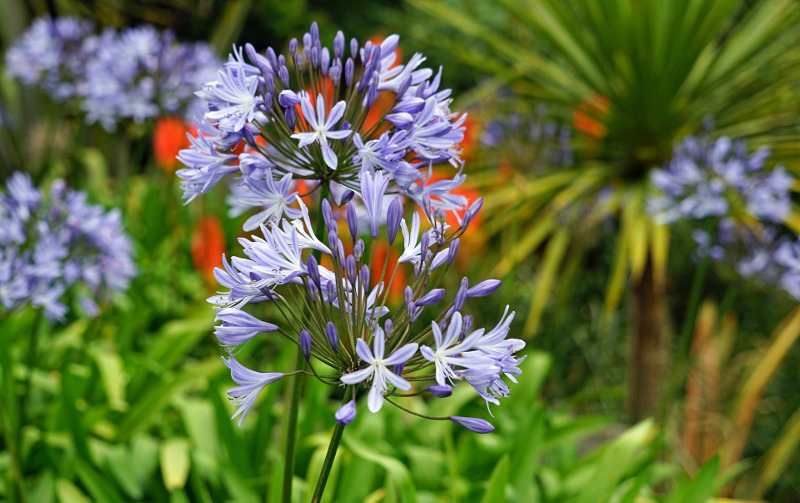Agapanthus Care Tips for Lush and Vibrant Flowers
Agapanthus Care Tips for Lush and Vibrant Flowers
Blog Article
Mastering the Art of Agapanthus Treatment: Crucial Actions for Healthy And Balanced Growth and Dynamic Blooms
In the world of cultivation, the farming of agapanthus stands as a rewarding endeavor for those who seek to nurture these sophisticated blooming plants. With their striking blossoms and stylish vegetation, agapanthus has caught the attention of garden enthusiasts worldwide. Nonetheless, accomplishing optimum development and vibrant blossoms needs a nuanced strategy that encompasses various vital steps. From choosing the right variety to grasping trimming strategies, the journey towards growing growing agapanthus plants is diverse and holds the crucial to unlocking the complete capacity of these botanical treasures.

Selecting the Right Agapanthus Range

When choosing the right Agapanthus selection for your garden, take into consideration aspects such as climate viability, flower color, and growth behavior. In addition, think about the environment in your area to ensure the Agapanthus selection you choose can grow in your specific conditions. Recognizing the growth behavior of different Agapanthus varieties is important for proper positioning within your garden.
Perfect Planting Problems
Considering the optimum environmental needs is important for effective Agapanthus farming. Agapanthus grows in well-draining soil with a somewhat acidic to neutral pH level. When growing, choose a place that obtains complete sunlight to partial shade. In hotter environments, offering some mid-day shade can avoid scorching of the fallen leaves. Agapanthus plants are sensitive to chilly temperature levels and need to be protected from frost during wintertime months.
To guarantee healthy growth and dynamic flowers, plant Agapanthus bulbs at a depth of about 2-4 inches and space them 8-12 inches apart. Mulching around the base of the plants helps retain moisture and suppresses weed growth.
Watering and Fertilizing Tips
Preserving proper wetness levels and supplying vital nutrients are crucial elements in the care routine for Agapanthus plants. When it comes to sprinkling Agapanthus, it is essential to strike an equilibrium. These plants like consistently moist dirt but are prone to root rot if overwatered.
Feeding Agapanthus is vital for advertising healthy development and respected blooms. Apply a well balanced fertilizer, such as a 10-10-10 formula, in the very early spring as brand-new Go Here development arises. By complying with these watering and feeding pointers, you can ensure your Agapanthus plants flourish and create vibrant, lasting blossoms.
Trimming Strategies for Agapanthus
Trimming Agapanthus plants at the proper times and with appropriate techniques is vital for keeping their wellness and promoting ideal development and flowering. The optimal time to prune Agapanthus is in late winter or early spring before brand-new development arises. Begin by getting rid of any kind of dead or yellowing leaves near the base of the plant. Cut them as close to the ground as possible without damaging the emerging shoots.
Deadheading spent flowers can also reroute the plant's energy into generating more blossoms rather than setting seeds. If you desire to collect seeds for propagation, leave some blossoms to dry and mature on the plant.
Remember to make use of tidy, sharp devices to make exact cuts and minimize the risk of introducing diseases. Agapanthus. Normal trimming will aid maintain your Agapanthus looking healthy and neat while making certain a plentiful screen of attractive blossoms
Taking Care Of Usual Insects and Diseases
After ensuring proper pruning Clicking Here methods for Agapanthus, it is vital to attend to typical parasites and diseases that can affect the wellness and vigor of these plants. One usual pest that influences Agapanthus is the Agapanthus gall midge.
One more typical concern is fungal fallen leave spot, which offers as dark sores on the leaves. To stop fungal diseases, guarantee great air circulation around the plants, avoid overhanging watering, and get rid of any contaminated fallen leaves promptly. Additionally, Agapanthus plants can experience root rot if they are planted in badly draining dirt. To avoid this, plant Agapanthus in well-draining soil and prevent overwatering. By being watchful and taking punctual activity versus parasites and conditions, you can help your Agapanthus plants grow and create dynamic blooms.

Conclusion
Finally, grasping the art of agapanthus care entails picking the best variety, offering suitable planting conditions, proper watering and feeding, ideal trimming methods, and addressing common parasites and diseases. By adhering to these crucial actions, you can make certain healthy growth and vivid blooms for your agapanthus plants. Bear in mind to regularly monitor and preserve your plants to advertise their general well-being and durability.
To ensure healthy growth and dynamic blossoms, plant Agapanthus light bulbs at a depth of about 2-4 inches and area them 8-12 inches apart. By following these watering and fertilizing pointers, useful site you can guarantee your Agapanthus plants flourish and generate vibrant, long-lasting blossoms.
One typical pest that influences Agapanthus is the Agapanthus gall midget. Additionally, Agapanthus plants can experience from root rot if they are grown in inadequately draining soil. By following these necessary actions, you can ensure healthy growth and lively blossoms for your agapanthus plants.
Report this page